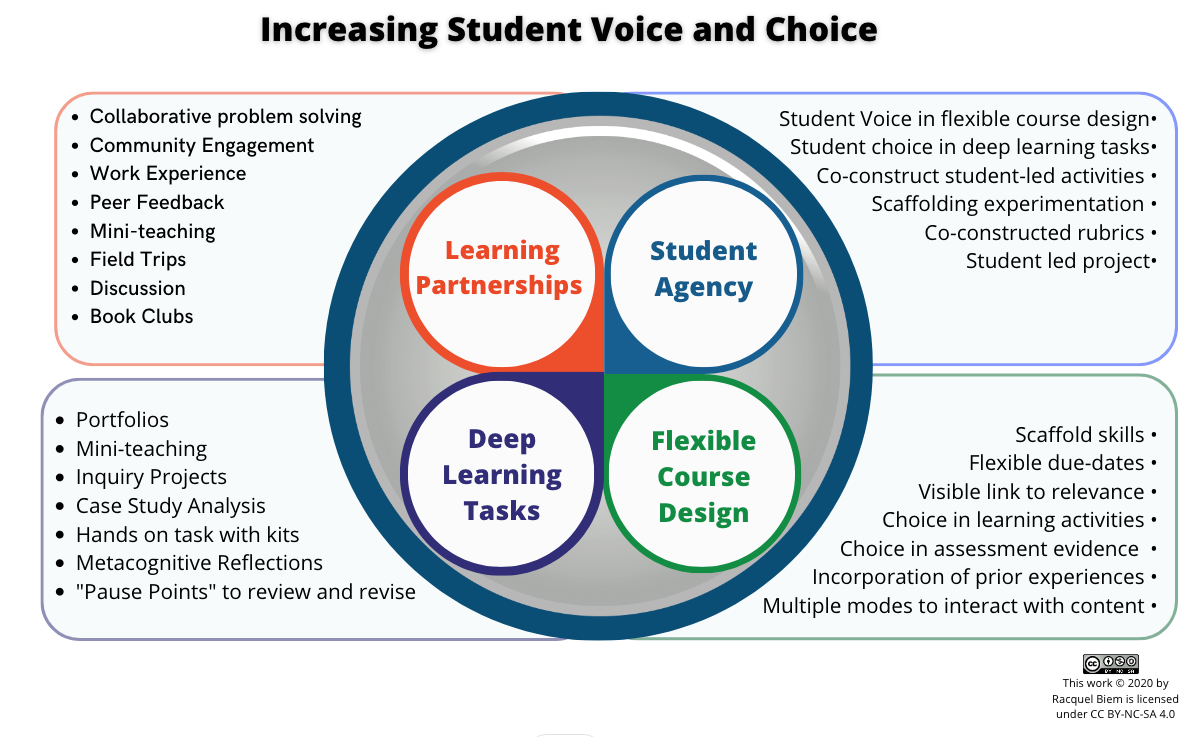All aligned – Instruction
In higher education, we have our students do all the hardest learning by themselves. As academics, our greatest strength is expertise, but we routinely select passive instructional strategies that have our students mostly listening to lectures in our classes and doing their learning later. Choosing passive listening robs us of the opportunity to provide the nuance and clarification that learners need while they learn. This post focuses on selecting the right type of instructional approaches to have our students actively learning the most important and challenging things they will need.
Relationship to our Learning Charter:There are two learning charter educator commitments related our instructional approaches to learning tasks:
- Be aware of the range of instructional methods and assessment strategies, and select and utilize teaching methods that are effective in helping students achieve the learning outcome of a course or learning activity
- Ensure that content is current, accurate, relevant to learning outcomes/objectives, representative of the knowledge and skills being taught and appropriate to the position of the learning experience within a program of study
Aligning the type of learning and your outcome: The type of learning you want your students to do dictates your instructional approach. If the task is to recall factual information, but not be able to use it is any way, lecture is actually a very effective way to communicate that information. Student will still need to rehearse it (memorize) by studying in order to learn, and sadly, will often forget much of it six months out. In addition, the most useful things taught by an expert are rarely basic facts. They are skills, concepts, and refined understandings, which novice students learn most effectively while actively engaging in learning facilitated by an expert. When we intersperse passive teaching with the right type of active learning given our outcomes, students are much more likely to learn the most challenging things we have to teach.
Choosing the right strategy:
- Determine the type of learning you want students to do (not just the content you want to cover) by writing or using a good learning outcome.
- Select an appropriate active approach, and intermix it with your passive approaches to increase the amount of student learning.
| Type of learning | Instructional approach |
| Knowledge: factual information like terms, classifications, and theorists | · Passive: Tell student about the knowledge (lecture, video, reading)
· Active: Have student use the facts in meaningful ways to learn them (mind-mapping, listing, drill and practice, sorting/drag and drop) |
| Conceptual: ideas understood well enough to apply it in new situations to assess or evaluate, like the concept of a successful argument or the concept of balanced | · Passive: Read a complex explanation, hear someone describe the concept
· Active: Classify or sort parts of the concept using criteria, refine an example of the concept, find errors, render judgement, construct an example of the concept, compare personal understanding to an example or rubric, reflect on growth of conceptual understanding over time |
| Process (cognitive): use a series of mental steps to accomplish a task, like solving for X
Process (psycho-motor or physical): use a series of physical steps with the right degree of acuity, like a neat set of the correct stitches |
·Passive: observe someone do the steps
·Active: Try to do the steps, put the steps in order, find errors in someone else doing the steps, predict what will happen if the steps are done wrong, reflect on personal success in completing the steps |
| Skill: Combing multiple types of learning to accomplish a goal, for example identify the critical parts of a complex problem, choose the order to do it in, and solve the problem correctly | · Passive: Hear about or see someone else using the skill
· Active: Try the skill in context (experiential learning) and reflect on success, complete a simulation, generate a decision-making tree or matrix, construct an argument on the implications of the application of the skill by someone else, provide feedback to another person by comparing their use of the skill to criteria |
Learn more:
Read the other blogs in this sequence about constructive alignment:
Read the other chats related to Our Learning Charter to learn about other educator commitments.


